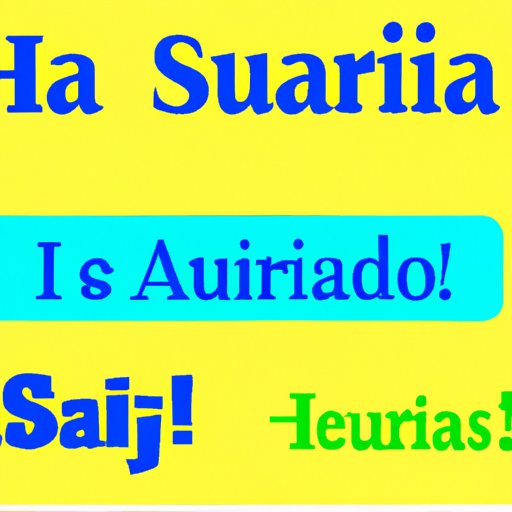Introduction
If you’re learning Spanish, one of the most important things to understand is how to greet someone in a formal and informal setting. Knowing how to greet someone properly is essential for any language, but in Spanish, there are distinct differences between formal and informal greetings. In this article, we will explore the different ways to say “how are you” in Spanish, both formally and informally.

Cómo Estás en Español: Una Guía Formal e Informal
When greeting someone in Spanish, it is important to know which type of greeting is appropriate for the situation. In a formal setting, it is customary to greet someone with a phrase such as “buenos días” or “buenas tardes”, which translates to “good morning” and “good afternoon” respectively. In an informal setting, it is more common to greet someone with a phrase such as “hola” or “¿qué tal?”, which translates to “hello” and “how are you?” respectively.

Hablando Español: Aprende a Saludar Formalmente y de Manera Informal
In Spanish, there are many different phrases that can be used to greet someone formally or informally. When speaking formally, it is polite to greet someone with a phrase such as “encantado de conocerle”, which translates to “pleased to meet you”. Other common formal greetings include “mucho gusto” (nice to meet you) and “saludos” (greetings).
In an informal setting, it is more common to greet someone with a phrase such as “¿qué pasa?” or “¿qué hay?”, which translates to “what’s up?” or “what’s going on?” respectively. Other common informal greetings include “¿cómo te va?” (how are you doing?) and “¿qué tal?” (how’s it going?).
¿Cómo Estás? Explorando la Diferencia entre el Español Formal y el Informal
When asking “how are you?” in Spanish, it is important to remember the difference between formal and informal Spanish. In a formal setting, it is polite to ask “¿cómo está?” or “¿cómo se encuentra?”, which both translate to “how are you?”. In an informal setting, it is more common to ask “¿cómo estás?”, which translates to “how are you?”
It is important to note that the verb conjugation changes depending on the formality of the situation. In a formal setting, the verb should be conjugated in the third person singular (él/ella/usted), while in an informal setting, the verb should be conjugated in the second person singular (tú). This is the same for other verbs such as “to be” and “to have”.
¡Hola! Aprendiendo los Usos del Español Formal e Informal
When speaking Spanish, it is important to understand the differences between formal and informal language. In a formal setting, it is polite to use phrases such as “por favor” (please) and “gracias” (thank you). It is also important to remember to use the third person singular conjugation of verbs. In an informal setting, it is more common to use phrases such as “dale” (okay) and “listo” (ready). In this setting, it is also more common to use the second person singular conjugation of verbs.
Hablando Español: Una Breve Introducción al Lenguaje Formal e Informal
When speaking Spanish, it is important to understand the differences between formal and informal language. In a formal setting, it is polite to use phrases such as “buenos días” (good morning) and “buenas tardes” (good afternoon). It is also important to remember to use the third person singular conjugation of verbs. In an informal setting, it is more common to use phrases such as “hola” (hello) and “¿qué tal?” (how are you?). In this setting, it is also more common to use the second person singular conjugation of verbs.

El Español: Una Mirada a la Diferencia Entre el Uso Formal e Informal
When speaking Spanish, it is important to understand the differences between formal and informal language. Understanding the different forms of Spanish used in formal and informal settings will help you communicate effectively and correctly with native speakers. Examples of how to use formal and informal Spanish when asking “how are you” include “¿cómo está?” (formal) and “¿cómo estás?” (informal).
Conclusion
In conclusion, knowing the difference between formal and informal Spanish is essential for any Spanish learner. Greetings such as “buenos días” (good morning) and “hola” (hello) are commonly used in formal and informal settings respectively. When asking “how are you?”, it is important to remember to use the correct verb conjugation depending on the formality of the situation. Understanding the different forms of Spanish used in formal and informal settings will help you communicate effectively and correctly with native speakers.
(Note: Is this article not meeting your expectations? Do you have knowledge or insights to share? Unlock new opportunities and expand your reach by joining our authors team. Click Registration to join us and share your expertise with our readers.)
